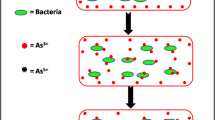Abstract
During bacterial oxidation of the arsenopyrite that contaminated a chalcopyrite concentrate, the bioextraction of arsenic from the concentrate was examined. A long-term constant As(III) concentration, representing a large portion of the total arsenic, occurred in the leaching medium. As(III) was not further oxidized, either under bioextraction conditions or by Fe(III) in the presence of the mesophilic bacterium Thiobacillus ferooxidans. These results are discussed in relation to the influence of leaching microorganisms on the form of arsenic in the solution. Dissolved As(III) could be reversed into a solid phase by adsorption of As(III) by forming an iron precipitate.
Similar content being viewed by others
References
Barrett J, Ewart DK, Hughes MN, Nobar AM, Poole RK (1990) The oxidation of arsenic in arsenopyrite: the toxicity of As(III) to a moderately thermophilic mixed culture. In: Salley J, McCready RGL, Wichlacz PL (eds) Biohydrometallurgy 1989. Canada Centre for Mineral and Energy Technology, Ottawa, pp 49–57
Basaran AH, Tuovinen OH (1986) An ultraviolet spectrophotometric method for the determination of pyrite and ferrous ion oxidation by Thiobacillus ferrooxidans. Appl Microbiol Biotechnol 24:338–341
Collinet MN, Morin D (1990) Characterization of arsenopyrite oxidizing Thiobacillus. Tolerance to arsenite, arsenate, ferrous and ferric ions. Antonie van Leeuwenhoek 57:237–244
Livesey-Goldblatt E, Norman P, Livesey-Goldblatt DR (1983) Gold recovery from arsenopyrite/pyrite ore by bacterial leaching and cyanidation. In: Rossi G, Torma AE (eds) Recent progress in biohydrometallurgy. Associazione Mineraria Sarda, Iglesias, pp 627–641
Mandl M, Macholán L (1990) Membrane biosensor for the determination of iron(II,III) based on immobilized cells of Thiobacillus ferrooxidans. Folia Microbiol 35:363–367
Myers DJ, Osteryoung J (1973) Determination of arsenic(III) at the parts-per-billion level by differential pulse polarography. Anal Chem 45:267–271
Nishimura T, Tozawa K (1988) Kinetics of oxidation of arsenic(III) by aqueous ozone. Metall Rev MMIJ 5:24–37
Panin VV, Karavaiko GI, Polkin SI (1985) Mechanism and kinetics of bacterial oxidation of xulphide minerals. In: Karavaiko GI, Groudev SN (eds) Biogeotechnology of metals. Centre of International Projects GKNT, Moscow, pp 197–215
Silverman MP, Lundgren DG (1959) Studies on the chemoautotrophic iron bacterium Ferrobacillus ferrooxidans. I. An improved medium and a harvesting procedure for securing high cell yields. J Bacteriol 77:642–647
Tamura H, Goto K, Yotsuyanagi T, Nagayama M (1974) Spectrophotometric determination of iron(II) with 1,10-phenanthroline in the presence of large amounts of iron(III). Talanta 21:314–318
Author information
Authors and Affiliations
Additional information
Correspondence to: M. Mandl
Rights and permissions
About this article
Cite this article
Mandl, M., Matulová, P. & Dočekalová, H. Migration of arsenic(III) during bacterial oxidation of arsenopyrite in chalcopyrite concentrate by Thiobacillus ferrooxidans . Appl Microbiol Biotechnol 38, 429–431 (1992). https://doi.org/10.1007/BF00170099
Received:
Accepted:
Issue Date:
DOI: https://doi.org/10.1007/BF00170099




